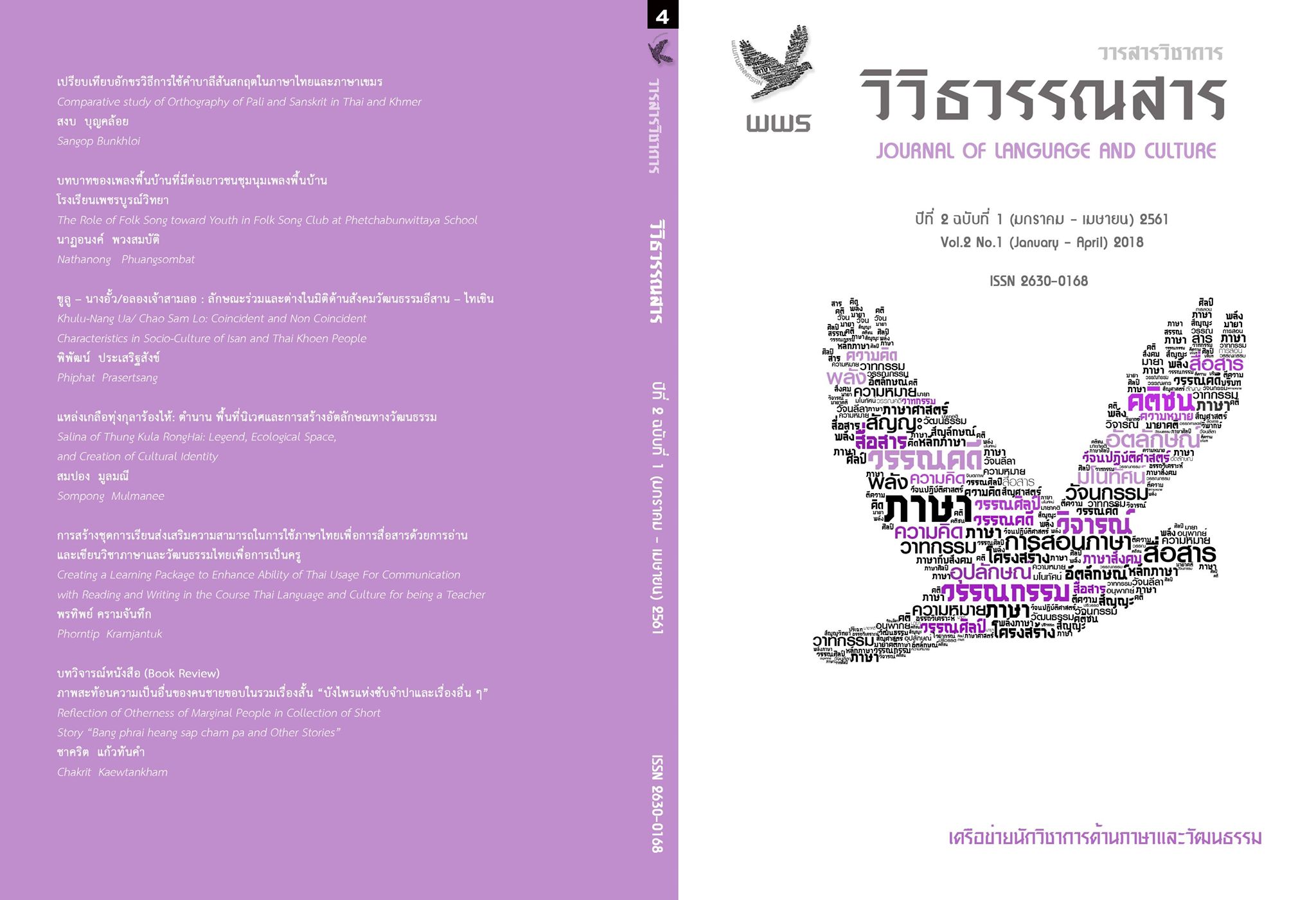การสร้างชุดการเรียนส่งเสริมความสามารถในการใช้ภาษาไทยเพื่อการสื่อสารด้วยการอ่านและเขียนวิชาภาษาและวัฒนธรรมไทยเพื่อการเป็นครู
Main Article Content
บทคัดย่อ
การวิจัยครั้งนี้ มีวัตถุประสงค์เพื่อ 1) สร้างชุดการเรียนส่งเสริมความสามารถในการใช้ภาษาไทย เพื่อการสื่อสารด้วยการอ่านและเขียนวิชาภาษาและวัฒนธรรมไทยเพื่อการเป็นครู ให้มีประสิทธิภาพตามเกณฑ์ 80/80 2) เปรียบเทียบผลสัมฤทธิ์ทางการเรียนจากการใช้ชุดการเรียนส่งเสริมความสามารถในการใช้ภาษาไทยเพื่อการสื่อสารด้วยการอ่านและเขียนวิชาภาษาและวัฒนธรรมไทยเพื่อการเป็นครู ก่อนเรียนและหลังเรียน เครื่องมือที่ใช้ในการวิจัยประกอบด้วย ชุดการเรียนส่งเสริมความสามารถในการใช้ภาษาไทยเพื่อการสื่อสารด้วยการอ่านและเขียนวิชาภาษาและวัฒนธรรมไทยเพื่อการเป็นครูกลุ่มเป้าหมายการวิจัย เป็นนักศึกษาสาขาวิชาภาษาไทย ชั้นปีที่ 1 คณะครุศาสตร์ มหาวิทยาลัยราชภัฏพิบูลสงคราม ในรายวิชา ภาษาและวัฒนธรรมไทยเพื่อการเป็นครู จำนวน 60 คน สถิติที่ใช้ในการวิเคราะห์ข้อมูลคือ ค่าประสิทธิภาพของกระบวนการ (E1) ค่าประสิทธิภาพของผลลัพธ์ (E2) ค่าเฉลี่ย ส่วนเบี่ยงเบนมาตรฐานและการทดสอบค่าที (t-test) ผลการวิจัยพบว่า 1) ชุดการเรียนส่งเสริมความสามารถในการใช้ภาษาไทยเพื่อการสื่อสารด้วยการอ่านและเขียนวิชาภาษาและวัฒนธรรมไทยเพื่อการเป็นครู ที่สร้างขึ้นมีประสิทธิภาพ 80.43/87.5ตามเกณฑ์มาตรฐานที่ตั้งไว้2) ความสามารถในการใช้ภาษาไทยเพื่อการสื่อสารด้วยการอ่านและเขียนวิชาภาษาและวัฒนธรรมไทยเพื่อการเป็นครูของนักศึกษาสาขาวิชาภาษาไทยหลังเรียนสูงกว่าก่อนเรียนอย่างมีนัยสำคัญทางสถิติที่ระดับ .01
Article Details
ลิขสิทธิ์ของบทความเป็นของวารสาร การพิมพ์ซ้ำจะต้องได้ร้บการอนุญาตจากบรรณาธิการวารสาร
เอกสารอ้างอิง
krungthep tam radap ayu phu phut. (in Thai). [Tonal Variation in
Thai : The age of speaker]. Bangkok : The research Project of Thai
Language, Chulalongkorn University.
Cooke, Joseph R. (1968). Pronominal Reference in Thai, Burmese, and
Vietnames. Bereley : University of California Press.
Haruethaiwinyu, S. (2002). Kan sueksa rabop burut sapphanam phasa
Thai nai samai rattanakosin nai naeo prawat. (in Thai).
[A Historical linguistics study of personal pronoun system Rattanakosin
Period]. Bangkok : The research Project of Thai Language,
Chulalongkorn University.
Jiaphong, S. (2011). Sangkhom lae watthanatham thi sathon chak
kan chai kham burut sapphanam : Kan sueksa priapthiap kham
burut sapphanam nai phasa Thai si thin. (in Thai). [Society and
culture in pronouns : A comparative in 4 Thai Dialects]. Journal of
Humanities Naresuan University. 8 (3) : 66-89.
Kunlawanit, P. (2002). Linguistic typology. Bangkok : The research Project
of Thai Language, Chulalongkorn University.
Naksakun, K (1995). Sapphanam nai phasa Thai sathon watthanatham
Thai. (in Thai). [Pronouns in Thai reflect Thai culture]. Journal of Thai
Language Institute. 2 (1) : 16-25.
Palakornkul, A. (1972). A Socio-Linguistic Study of Pronominal Strategy in
Spoken Bangkok Thai. Doctoral Deseratation, University of Texas,
U.S.A.
Prasitratthasin, A. (1998). Phasasat sangkhom. (in Thai). [Sociolinguistics].
Bangkok. Chulalongkorn University.
Saengsot, S. (1989). Kham burut sapphanam nai phasa Thai : Kan sueksa
choeng prawat. (in Thai). [The study of personal pronoun : Historical
linguistics]. Bangkok : The research Project of Thai Language,
Chulalongkorn University.
Sankhaburanurak, S. (1999). Kan chai kham laksananam nai phasa Thai
mattrathan patchuban khong phu phut tang wai. (in Thai).
[The use of classifiers in standard Thai of difference age]. Bangkok :
The research Project of Thai Language, Chulalongkorn University.
Strecker, David S.(1984). Proto-Tai Personal Pronouns. Doctoral Deseratation,
University of Michigan, U.S.A.


